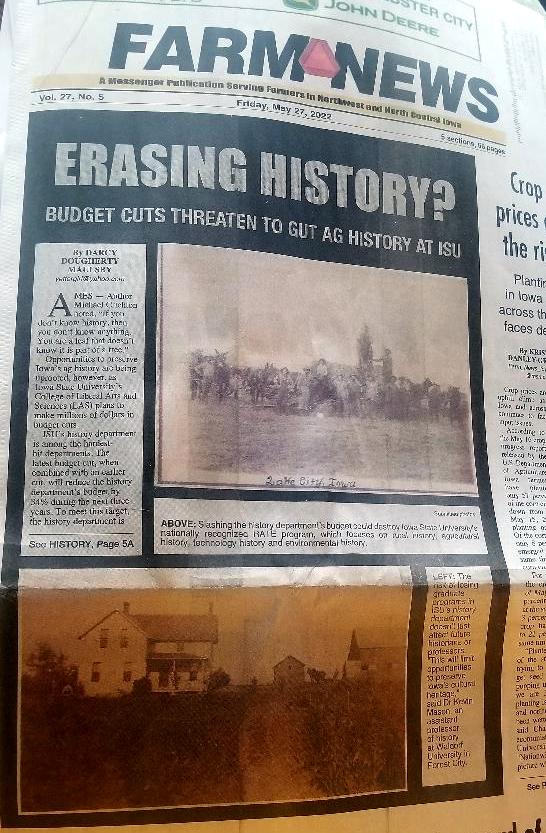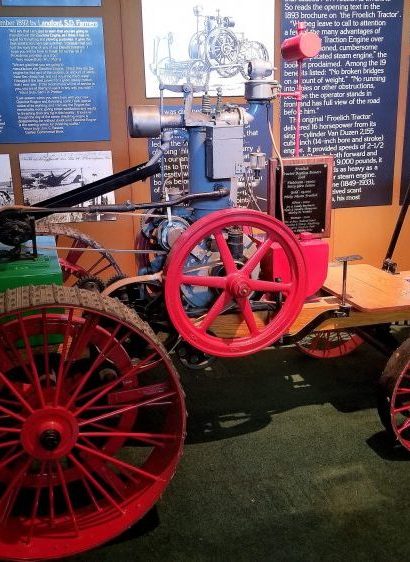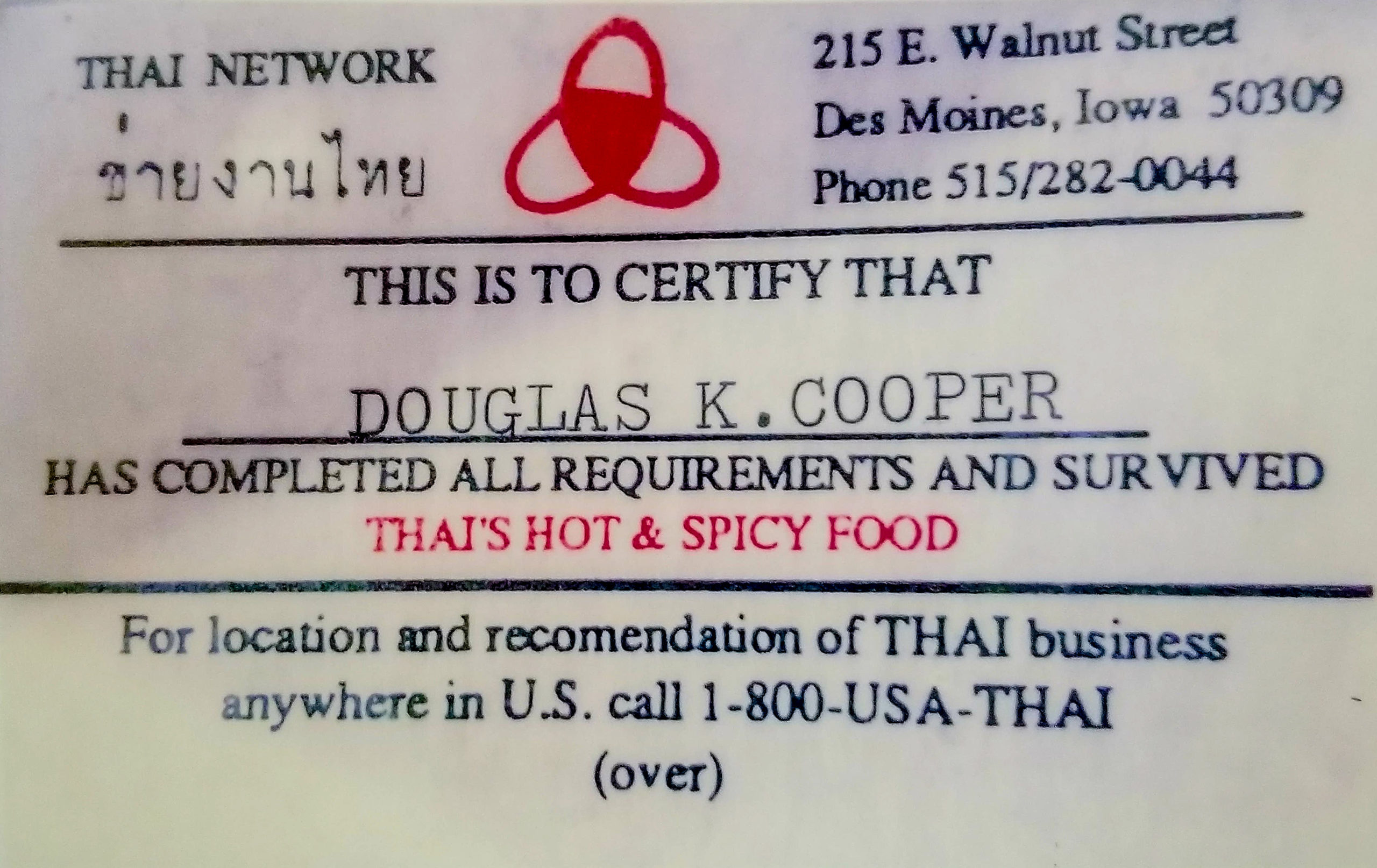
Whats HOT
Latest Posts
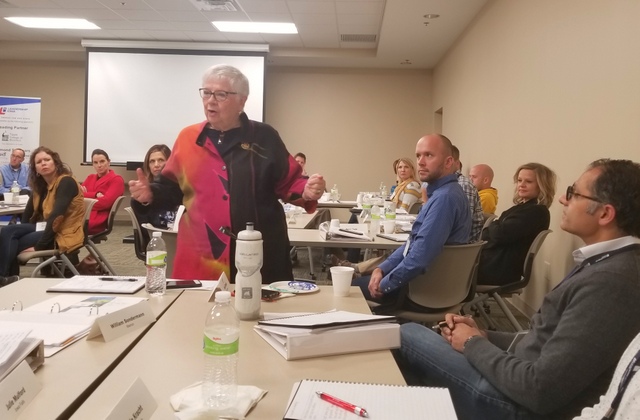
How Did We Get So Rude?
Ever come across something that takes on a deeper meaning every time you hear it? That’s how I felt when I scanned an online top 10 list of new year’s quotes and saw #8:
“Be at war with your vices, at peace with your neighbors and let every new year find you a better man.” — Benjamin Franklin
Seems like our society is increasingly mixing up the first two pieces of advice to the point where more people are at war with their neighbors and at peace with their vices, at least when it comes to rudeness. How did we get so rude? It made me think back to when I heard Mary Kramer articulate this pivotal issue.
I was in Winterset this fall when Kramer spoke to our class at Leadership Iowa, which is designed to instill passion in Iowa’s current and emerging leaders while fostering a high level of civic engagement. I saw a lot of heads nodding in agreement when Kramer, a former Republican state senator who was elected president of the Iowa Senate in 1997, tackled head-on the erosion of civil public discourse in America.
“We used to be able to debate with our adversaries without resorting to the demonization of one another,” said Kramer, a former United States Ambassador to Barbados and the Eastern Caribbean. “Back then, debates on important issues were challenging–even fun. Demonization used to be a last resort. Now we seem to begin with it.”
Demonization involves a shift from debating issues to attacking people. If we can destroy the career or the character of someone who is “getting it all wrong,” all would be well, or at least better.
It’s noxious process, Kramer stressed. Viewing those we disagree with as the embodiment of evil results in a profound loss of perspective on the humanity of our opponents. They stop being human beings like us, who happen to disagree on some issues.
Demonization isn’t limited to politics. It has spread like a cancer into entertainment, 24-hour news, social media and beyond. Its ubiquitous presence tempts people to cross the line between civility and rudeness without a second thought.
It also distorts reality. Just because someone passionately believe in something, does that belief allow him or her to mandate these views on everyone else?
No.
Not here, where generations of Americans have honored our heritage of meeting together, sharing information about a broad range of issues and seeking common ground. While our history isn’t one of perfect unity (far from it), we still found a way to move forward for the common good.
Let’s learn from the past and remind ourselves that the keys to combating this current rash of rudeness aren’t complex. They just require some human decency, a little kindness and a willingness to start with one key question: what problem are we trying to solve? I agree with Kramer that working together to agree on the problem statement often introduces common ground.
• Next, listen. Too often we underestimate the power of truly listening to others. Listen with curiosity, rather than “listening” with the intent to reply.
• Ask clarifying questions. Try to understand why people believe the way they do. Don’t just rush to judgement. Ask sincere (not snarky) questions, and try to discover what motivates someone to feel the way they do. As a writer who has interviewed thousands of people, I’m still sometimes shocked by the answers people give me. Plus, their viewpoints either challenge me to reconsider my own views or at least clarify why I believe what I believe.
• Acknowledge the validity of the other person’s position. While you don’t have to agree with someone’s viewpoint, you can and should acknowledge their position. Consider a controversial topic like water quality. Even if I don’t agree with someone’s opinion about the way to address this challenge, I can acknowledge this person’s concerns and validate the goal of clean, healthy drinking water.
Sure, not everyone who disagrees with you will follow this advice. Still, you’ve set the stage for more productive conversations, rather than head-on collisions propelled by rudeness.
Also, be encouraged by these words that Kramer came across years ago and shared with us at Leadership Iowa:
• Iowa is the place where the dream still lives.
• Iowa is the America we grew up believing in. It is liberty bought by hard work and integrity.
• It’s the belief that the future will be even better than today if we will work to make it that way.
So – can we talk? More important, can we listen?
This column originally appeared in January 2018 in Farm News.
P.S. Thanks for joining me. I’m glad you’re here.
Want more?
Thanks for stopping by. I invite you to read more of my blog posts if you value intriguing Iowa stories and history, along with Iowa food, agriculture updates, recipes and tips to make you a better communicator.
If you like what you see and want to be notified when I post new stories, be sure to click on the “subscribe to blog updates/newsletter” button at the top of this page, or click here. Feel free to share this with friends and colleagues who might be interested, too.
If you’re hungry for more stories of Iowa history, check out my top-selling “Culinary History of Iowa: Sweet Corn, Pork Tenderloins, Maid-Rites and More” book from The History Press. Also take a look at my latest book, “Dallas County,” and my Calhoun County” book from Arcadia Publishing. Both are filled with vintage photos and compelling stories that showcase he history of small-town and rural Iowa. Order your signed copies today! Iowa postcards are available in my online store, too.
Also, if you or someone you know could use my writing services (I’m not only Iowa’s storyteller, but a professionally-trained journalist with 20 years of experience), let’s talk. I work with businesses and organizations within Iowa and across the country to unleash the power of great storytelling to define their brand and connect with their audience through clear, compelling blog posts, articles, news releases, feature stories, newsletter articles, social media, video scripts, and photography. Learn more at www.darcymaulsby.com, or e-mail me at yettergirl@yahoo.com.
Let’s stay in touch. I’m at darcy@darcymaulsby.com, and yettergirl@yahoo.com.
Talk to you soon!
Darcy
@Copyright 2018 Darcy Maulsby & Co.
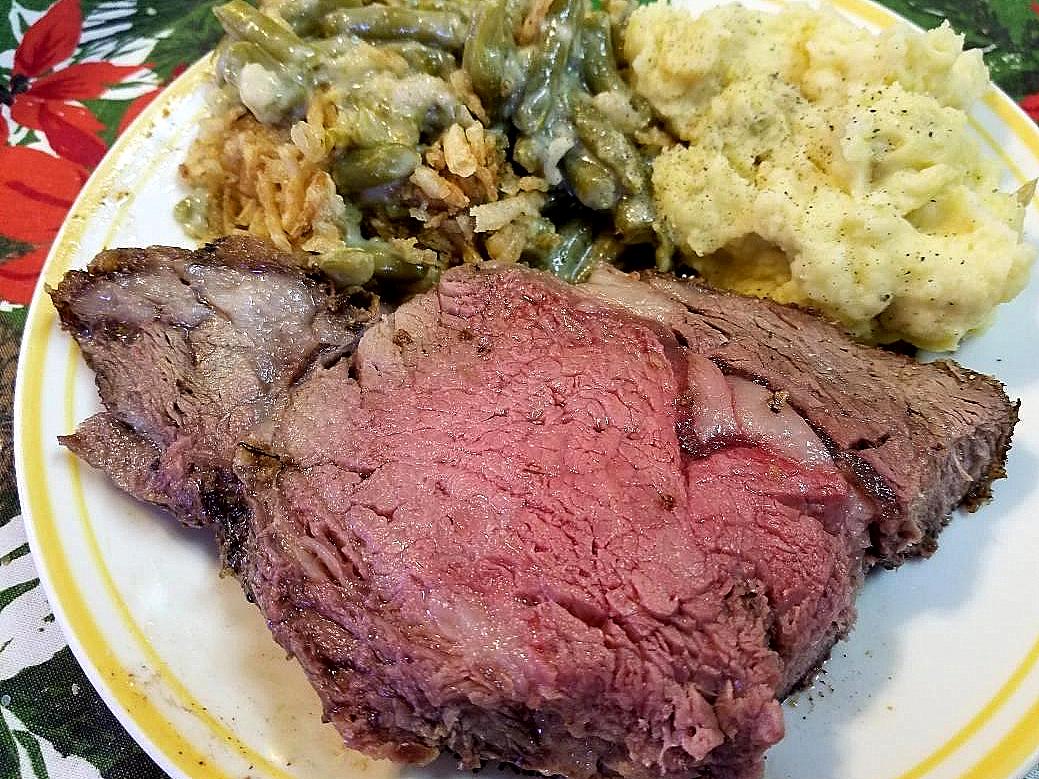
How to Cook a Perfect Prime Rib
Would you believe me if I told you restaurant-quality prime rib is one of the easiest main courses to prepare, plus you’ll look like a gourmet chef in the process? Yep, it’s true.
Take it from this Iowa farm girl. I adore the taste of prime rib. So tender, so robust, and bursting with all the flavor and juiciness that makes each bite a little trip to paradise.
When my family asked me to cook prime rib for New Year’s Day dinner, I didn’t hesitate. The prep couldn’t be simpler, and the results are simply spectacular. When you serve this delectable prime rib, your guests (possibly even the vegetarians) will be begging for more.
Let’s get cookin.’
Darcy’s Prime Rib
Select the right size roast. Allow at least 6 ounces of cooked, trimmed meat per adult. I cooked an 8-pound roast for our gathering, because I like to have leftovers. Beef and veggie soup, anyone?
Preheat the oven. Crank it up to 450 degrees Fahrenheit, and let it heat up for about 30 minutes. Also, you can remove the beef roast from the refrigerator at this time.
Gather your supplies. I recommend a metal roasting pan with a rack (like the one you might use to cook at turkey), olive oil, kosher salt, and fresh-ground pepper. Oh, and don’t forget to round up some soap and wash your hands thoroughly. We’re in the kitchen prepping food, after all!

Rachet-style pepper mill in red!
• A side note about fresh-ground pepper. I LOVE my Kuhn Rikon® high-output ratchet mill. (Check out a video here to see it in action). I appreciate the easy and speed of these wonder gadgets, plus I adore the red color of my pepper mill, since it matches my kitchen. One more thing—don’t think you’re limited to filling it with black peppercorns only. After interviewing a chef years ago about how to amp up the flavor in any dish, I took his advice and use of mix of peppercorns, including black, green, red and white, which bring a different flavor to the party.
Season the beef. Follow the K.I.S.S. method (keep it simple stupid). Prime rib roast doesn’t need a marinade or any complicated preparations, since the meat speaks for itself. Drizzle olive oil on the roast. Spread it around the roast with your hands. Next, liberally rub kosher salt and plenty of fresh-ground pepper on the meat. I don’t measure—I just go with what looks right.
If you’re thinking about using an herb mix to season the meat, I say go right ahead. I like to use this homemade herb blend that I learned to make at my dear friend Shannon Latham’s Enchanted Acres pumpkin patch near Sheffield, Iowa. I’m a big fan of the recipe here for Save Summer in a Jar Herb-Salt Mix and used it on my New Year’s prime rib–divine! Thanks to my friend Mary Lovstad of Farm Girl Cook’n in northern Iowa for all the inspiration!
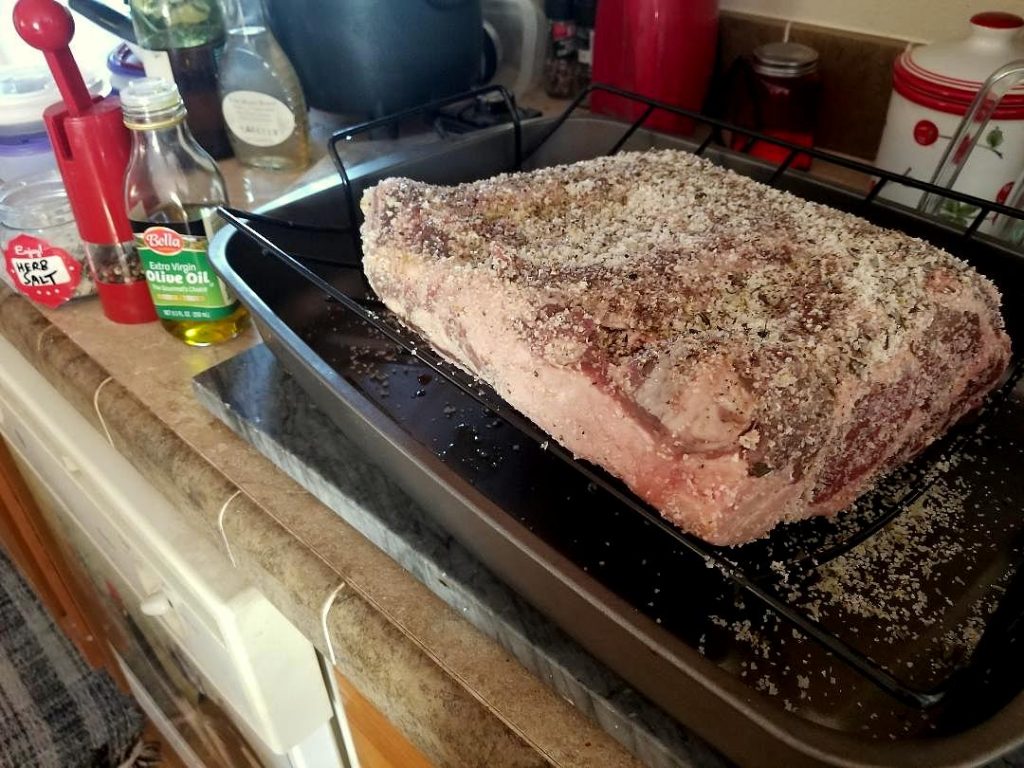
Dry rubs enhance any beef roast
Bake. Place the meat in a roasting pan that’s slightly bigger than the roast itself. I like a roasting pan and roasting rack, myself. Note–one side of the meat will have more fat on it. You want the fatty side facing up so the meat will baste itself as it cooks.
Finally, don’t add water to the pan, and don’t cover the roast. Just pop it in in the oven.
Timing is everything. How long does it take to cook a prime rib? Well, it depends. I like to start with a high temperature (450 degrees) for the first 30 minutes. Then I drop the heat to 325 degrees and allow about 13 to 15 minutes of cooking time per pound of beef.
DO NOT keep opening the oven door to check the meat. Just enjoy the tempting sizzle as the pan drippings appear during the first phase of cooking. Then savor the aromas as the beef finishes cooking over the next few hours.
A thermometer is the best way to guarantee the roast turns out exactly the way you want it. For an accurate reading, push the thermometer into the middle of the roast, making sure the tip is not touching fat or bone (or the pan). FYI–medium rare is about 130 degrees F. If that’s what you’re going for (confession–it’s my personal favorite), take the meat out of the oven when it’s around 120 degrees F. Remember that the roast’s temperature will rise at least 5 degrees after you remove it from the oven.
Let it rest. Warning—the prime rib will look incredible when you pull it out of the oven, but resist the urge to carve it right away. Let this meaty masterpiece rest for 15 or 20 minutes before carving to let the juices return to the center. Cover the roast with a “tent” of tinfoil. (If you’re at my house, be warned. My dog, Maggie the Red Heeler, is obsessed with tinfoil and will bark like a maniac when I tear a sheet of foil from the roll. Silly dog.)
With prime rib, it’s easy to satisfy everyone’s preference for doneness. The slices taken from the ends of the roast will be the most done, and the middle will be the least done.
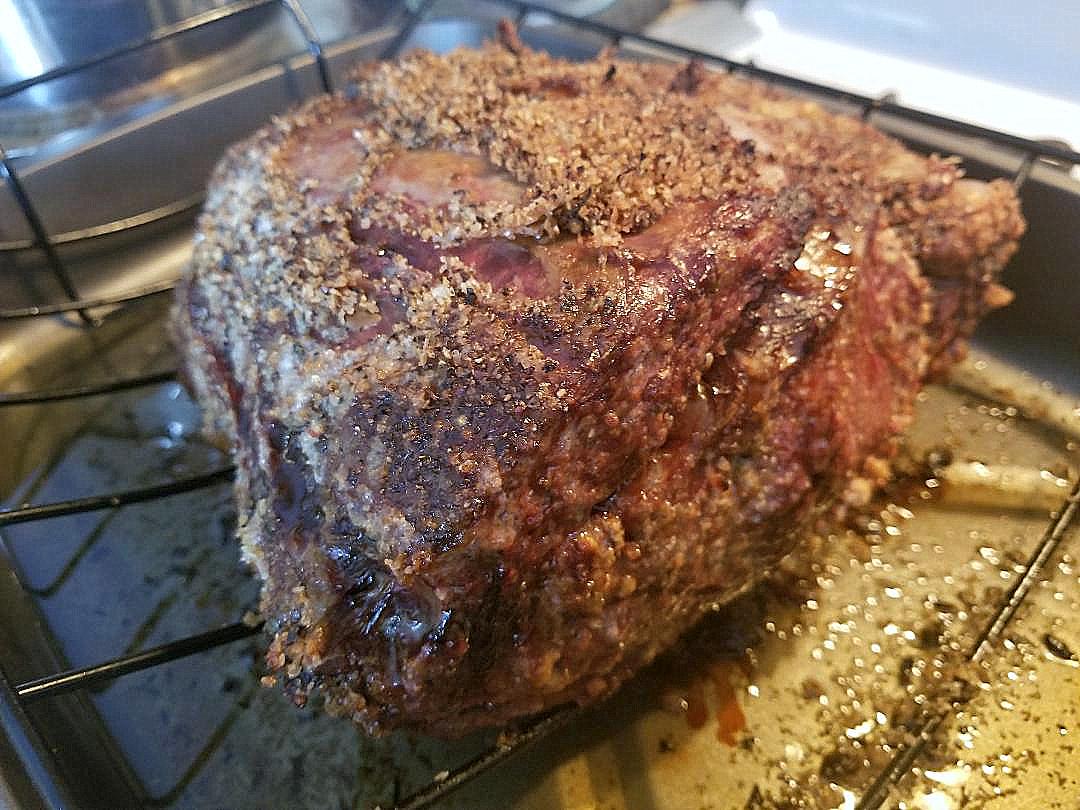
Prime rib right out of my oven
Add a little something extra. When the roast is done make sure you use the drippings in the bottom of the pan to make gravy. Then you’ll have a head-start on the most flavor-packed beef stew you can imagine.
Next time I prepare a prime rib, I’m going to try Food Network Chef Bobby Flay’s idea for Prime Rib with Thyme au Jus. Here’s what he recommends:
Place the roasting pan on top of the stove over 2 burners set on high heat. Add the wine to the pan drippings in the pan and cook over high heat until reduced, scraping the bottom of the pan with a wooden spoon. Add the stock and cook until reduced by half. Whisk in the thyme and season with salt and pepper, to taste.
Tell me all about it. Bottom line? Do not fear cooking prime rib, even though this is a pricey cut. You can do this! When you do, be sure to leave a comment, e-mail me, post on social media and tell me all about it.
Did you know?
“Prime rib” is not a specific cut of beef but is actually a preparation method for a beef rib roast. If you know the standard meat roasting method, you can make prime rib out of several types of beef rib roasts, according to my friends at the Iowa Beef Industry Council.
Check out their handy Beef Roast Basics guide. You’ll find tips on how to know what size beef roast to purchase, how to carve meat like a pro and more.

How’s this for a plate of prime rib perfection?
More reasons why beef is good
With my background as an ag journalist, I love to highlight agriculture, especially Iowa agriculture. Why do we know beef here in the Heartland? Because Iowa is in the top 10 beef-producing states in America, terms of all cattle and calves (ranking #7).
Here’s a snapshot of Iowa’s beef industry, which is a powerhouse in terms of economic development and providing a safe, nutritious product that nourishes people around the world:
- Total cattle inventory in Iowa (as of January 1, 2017): 3,850,000
- Number of feedlots (2012 Census): 6,036
- Number of cattle operations (2012 Census): 26,827
- Number of farms with beef cows (2012 Census): 19,677
- Iowa jobs directly related to the cattle industry (2015): 20,690
- Iowa jobs indirectly related to the cattle industry (2015): 7,384
- In 2015, Iowa’s cattle industry contributed more than $6.9 billion in business activity to Iowa’s economy.* Sources: Department of Economics, Iowa State University; Iowa Agricultural Statistics, U.S. Department of Agriculture; 2017 Cattle Inventory Report National Agricultural Statistics Service (NASS), Agricultural Statistics Board, United States Department of Agriculture (USDA).
Can’t get enough beef?
There’s no such thing as too much beef if you love it as much as I do. I think my friend Larry Irwin would agree, especially when it comes to hamburgers.
Make no mistake, the humble hamburger still reigns supreme from backyard barbecues to fast-food drive-ins across Iowa. But this Iowa icon also provides the perfect palette for culinary creativity when Larry Irwin showcases his Burger of the Month flavors in my hometown of Lake City. Get the story and the recipes here.
Also, get your grill on and build a better burger with my top tips.
Finally, I just had to share this photo below. My relatives in Webster County, the Walrod family, did extremely well on the show circuit this year with their beef cattle and took top honors with their Limousin cattle at the Iowa State Fair. Why not decorate the Christmas tree to celebrate a banner year?
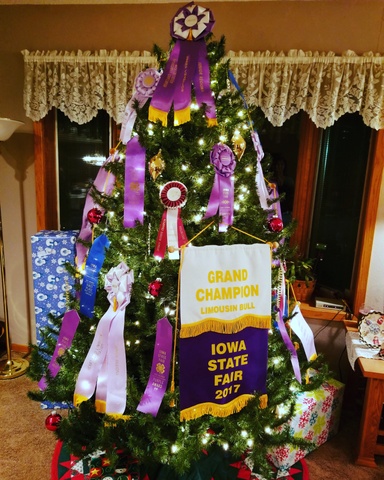
Cattle banners on the Christmas tree in Iowa
Want more?
Thanks for stopping by. I invite you to read more of my blog posts if you value intriguing Iowa stories and history, along with Iowa food, agriculture updates, recipes and tips to make you a better communicator.
If you like what you see and want to be notified when I post new stories, be sure to click on the “subscribe to blog updates/newsletter” button at the top of this page, or click here. Feel free to share this with friends and colleagues who might be interested, too.
If you’re hungry for more stories of Iowa history, check out my top-selling “Culinary History of Iowa: Sweet Corn, Pork Tenderloins, Maid-Rites and More” book from The History Press. Also take a look at my latest book, “Dallas County,” and my Calhoun County” book from Arcadia Publishing. Both are filled with vintage photos and compelling stories that showcase he history of small-town and rural Iowa. Order your signed copies today! Iowa postcards are available in my online store, too.
Also, if you or someone you know could use my writing services (I’m not only Iowa’s storyteller, but a professionally-trained journalist with 20 years of experience), let’s talk. I work with businesses and organizations within Iowa and across the country to unleash the power of great storytelling to define their brand and connect with their audience through clear, compelling blog posts, articles, news releases, feature stories, newsletter articles, social media, video scripts, and photography. Learn more at www.darcymaulsby.com, or e-mail me at yettergirl@yahoo.com.
Let’s stay in touch. I’m at darcy@darcymaulsby.com, and yettergirl@yahoo.com.
Talk to you soon!
Darcy
P.S. Thanks for joining me. I’m glad you’re here.
@Copyright 2018 Darcy Maulsby & Co.

Soy Power Shines at Historic Rainbow Bridge
I was furious the minute I saw it. Blue spray paint defaced the bronze historical marker attached to a large stone south of Lake City near Rainbow Bridge, a favorite destination where I take my dad, mom and trusty red heeler, Maggie, for Sunday drives.
I snapped a photo of the crude star scrawled across the marker in mid-August and posted it on social media to express my disgust. While outraged Facebook friends posted hundreds of comments lamenting the vandalism, few solutions emerged.
I’m no graffiti removal expert and didn’t know what to do next, so I turned to Google. My search led me to Natural Soy Products’ graffiti remover. Not only did the product promise to remove paint, but this eco-friendly solution is made from American-grown soybeans. When I found out the company is based in Brooklyn, Iowa, I was sold and ordered two bottles of Graffiti Remover.
I was still nervous, though. Was I doing the right thing?
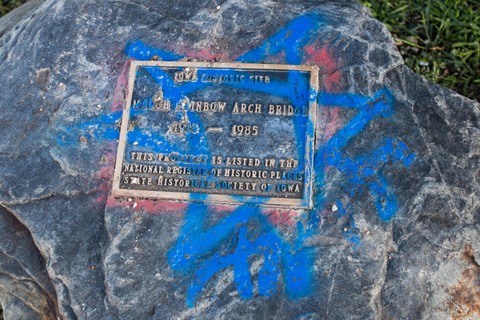
Look at this mess defacing this bronze marker that denotes the history of Rainbow Bridge. What a mess!
Rainbow Bridge spans generations of history
Iconic Rainbow Bridge has spanned the Raccoon River for more than a century southwest of Lake City and is an outstanding example of Iowa engineer James B. Marsh’s rainbow arch design. Hundreds of bridges with this distinctive “rainbow” profile were constructed in the 1910s and 1920s, mainly in the Midwest, though few remain.
Despite its storied history, the local Rainbow Bridge has long been a target for graffiti. Still, I kept thinking this latest act of vandalism had gone too far. I didn’t want to inflict more damage, though, in my attempt to clean up the mess.
Putting soy power to work
When my bottles of Graffiti Remover arrived, I rounded up a vegetable scrub brush, some rags, fresh water and my dog. We headed out to Rainbow Bridge late that afternoon to get to work.
While the Graffiti Remover label recommended waiting at least 10 minutes after spraying the cleaner, impatience got the best of me. I tried scrubbing off the paint after several minutes and was delighted to see promising results. In less than 15 minutes, I cleaned the entire marker and stone.
Always curious, I wanted to learn more. “Our products utilize the powerful, natural properties of soy,” said Joe Barber, president and CEO of Natural Soy Products, who responded to my inquiry. He added that soybean oil and soy methyl esters can be processed into a variety of useful products, from household cleaners to industrial applications.
Many of these products have evolved from innovations in the soy biodiesel industry. It’s exciting to see soy-based technology not only protecting history at Rainbow Bridge, but creating new solutions that will benefit our families and communities for generations to come.
(I first shared this story on my Facebook page in an abbreviated form. Ann Clinton, editor of the Iowa Soybean Review magazine, asked me to write the story for the Iowa Soybean Association‘s magazine. I was happy to oblige, and the piece you just read here appeared in the November 2017 issue. But wait–there’s more! I also wrote a different version of the story for Farm News‘ annual soybean section in the fall of 2017. Here’s the story below.)

Amazing what a non-toxic soy-based cleaner and a little elbow grease can do. The graffiti remover started dissolving the paint in minutes.
Cleaning Up with Soy Power: Iowa Company Redefines Eco-Friendly Cleaning Solutions
Environmentally-friendly cleaning products often make big promises, but the results don’t always live up the hype—unless soybeans are involved.
“Soy works great for cleaning products, lubricants and more,” said Craig Lang, former Iowa Farm Bureau Federation president and a farmer from Brooklyn, Iowa. “These products have come about because of innovations in the soy biodiesel industry.”
Soy-based cleaners and other soy-based products are a specialty of Natural Soy Products in Brooklyn, which uses soy oil and soy methyl esters to produce a wide array of consumer and industrial products. “I’ve seen some really amazing things with these bio-based products,” said Lang, who has worked with Natural Soy for almost three years. “They are highly effectively.”
The Graffiti Cleaner, for example, is used by customers from California to Chicago and beyond. Soy-based products like this not only clean up messes, but they can help protect water quality.
“Water quality is an issue that needs to be at the forefront,” said Joe Barber, president and CEO of Natural Soy Products LDT, a division of the Clean Environment Company. “A lot of chemicals get put down drains every day. Environmentally-friendly, soy-based cleaning products offer an alternative and can be part of the solution to improving water quality.”
Growing new opportunities in Iowa
Established in 2013, Natural Soy Products is owned by Ken Budke, a U.S. Army veteran and retired Cedar Falls dentist from Cedar Falls who’s an entrepreneur at heart. When Budke saw the potential of soy-based solutions for home and industrial use, he knew he was on to something, Barber said.
“Our products work, because they utilize the powerful, natural properties of soy,” Barber said. “Soybean oil and soy methyl esters can be processed into many different products that benefit consumers and local soybean farmers.”
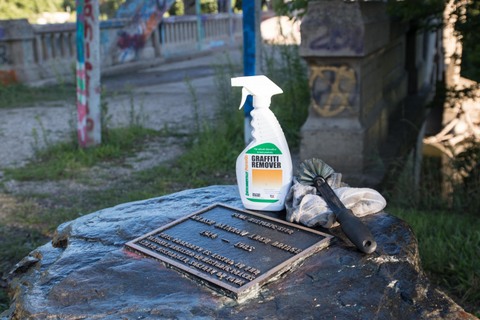
Here’s the soy-based graffiti remover I bought from Natural Soy in Iowa. It worked like a charm.
Household cleaning products from Natural Soy Products and the Clean Environment Company range from barbecue grill cleaner to hand degreasers to pet shampoo, along with toilet bowl cleaners and bathroom cleaners that make lime removal simple.
“Just because these are environmentally-friendly products doesn’t mean they don’t work,” said Barber, who noted that Natural Soy Products work well at home and in hospitals, nursing homes, businesses and more. “They are tough enough to get the job done, but gentle enough that you can get the product on your skin and it won’t cause any harm.”
Other soy-based products from the company are geared towards industrial use and perform well in harsh, dirty environments, Barber said. Lubricant sticks for the railroad industry are designed to protect the wheel/rail interface. These soy-based sticks offer higher lubricity than the traditional petroleum-based lubricants, providing greater maintenance and replacement cost savings. The solid material also provides a targeted application that greatly reduces maintenance costs.
Other soy-based industrial products from the company include an asphalt release concentrate that prevents asphalt from adhering to the bodies of dump trucks. A concrete sealer from Natural Soy Products includes a common ingredient that adds a plastic component to make this product even more effective.
“We have the ability to recycle Styrofoam and dissolve it into the soy blend,” Barber said. “If anything is spilled on top of the sealed concrete, this makes it easy clean up the mess.”
Iowa’s best-kept soy secret
Many of these innovative products were showcased in late August when Natural Soy Products welcomed guests from Expedition Farm Country 2017, a two-day bus tour of eastern Iowa ag hosted by the Iowa Food & Family Project.
“Natural Soy Products has to be one of Iowa’s best kept secrets,” said Shannon Latham, vice president of Latham High-Tech Seeds, which helped sponsor Expedition Farm Country to help urban consumers learn about Iowa agriculture. “What impresses me most is these products are industrial-strength, effective cleaners and lubricants, yet they’re safe for the environment.”
Latham also appreciates that Natural Soy Products is owned by a veteran, led by farmers and committed to supporting youth organizations like 4-H and FFA.
As Expedition Farm Country guests learned, a majority of Natural Soy Products’ production is located in the east-central Iowa town of Brooklyn, where the company has two locations. The company also has an office in Waterloo in the Cedar Valley TechWorks campus. The company employs about 10 people and is always looking for growth opportunities.
“Since we’re a small company, it can be challenging to compete with big corporations,” Barber said. “We’re identifying new ways to expand our distributor network and retail presence, though, while offering our products at a competitive price.”
While Natural Soy Products is based in Iowa, many of the companies’ products, especially the eco-friendly household cleaners, have found some of the most receptive markets far from the Midwest. Home cleaning products from the Clean Environment Company, for example, are popular on the East Coast and West Coast, while Natural Soy Products items have seen the most demand from the Rockies to the Ohio/Indiana region.
“While the majority of our sales are outside Iowa, we’re trying to change this,” Barber said.
Some of the company’s products can be found at Brothers Market in Parkersburg, for example. As more people hear about the benefits of home-grown soy solutions, the message is resonating with people, said Barber, who welcomes new inquiries from retailers wanting to carry items from Natural Soy Products and the Clean Environment Company.
“We need to make decisions today that will benefit our children and our children’s children,” Barber said. “Agriculture and soy products can be a big part of this.”
What are your best cleaning tips?
So I’m curious–do you have any favorite cleaning products or eco-friendly cleaning tips? If you do, feel free to leave a comment. I’d love to hear from you.
Here’s one of mine for cleaning those awful burned-on kitchen messes that happen sometimes, even to the best cooks:
Want more?
Thanks for stopping by. I invite you to read more of my blog posts if you value intriguing Iowa stories and history, along with Iowa food, agriculture updates, recipes and tips to make you a better communicator.
If you like what you see and want to be notified when I post new stories, be sure to click on the “subscribe to blog updates/newsletter” button at the top of this page. Feel free to share this information with friends and colleagues who might be interested, too.Also, if you or someone you know could use my writing services (I’m not only Iowa’s storyteller, but a professionally-trained journalist with 20 years of experience), let’s talk. I work with businesses and organizations within Iowa and across the country to unleash the power of great storytelling to define their brand and connect with their audience through clear, compelling blog posts, articles, news releases, feature stories, newsletter articles, social media, video scripts, and photography. Learn more at www.darcymaulsby.com, or e-mail me at yettergirl@yahoo.com.
Talk to you soon!
Darcy
P.S. Thanks for joining me. I’m glad you’re here.
Copyright 2017, Darcy Maulsby & Co.

Always Alert-How to Stay Safe in Any Situation
What was that? None of us knew what was going on at first, and I was confused—and alarmed.
It happened on the bright, sunny morning of October 16, as hundreds of us were gathered at 9 a.m. in the ballroom of the downtown Marriott Hotel in Des Moines for the Iowa Hunger Summit. I thought this would just be another routine meeting to cover. Boy, was I wrong.
After opening remarks from Ambassador Kenneth Quinn, president of the World Food Prize Foundation, and Iowa Farm Bureau Federation President Craig Hill, five former U.S. Department of Agriculture secretaries (including Tom Vilsack, Ed Schafer, Mike Johanns, Ann Veneman, and Dan Glickman) stepped on stage for a panel discussion. (You can read my recap of the panel discussion in my article “Hungry for Answers” in Farm News.)
Suddenly there was a ruckus from the back of the ballroom. There were voices shouting, although I couldn’t make out the words at first. Everyone began looking around to see what was going on. Was this a surprise part of the program?
Suddenly a small group of young men holding a large white banner painted with red lettering marched down the aisle. It soon became evident they were chanting about “hell no GMOs” over and over. A slender young woman dashed after them, capturing the footage on her cell phone.
It also became clear this group intended to stand between the bewildered audience and row of former ag secretaries on stage, as the protestors belted out their angry chant. I don’t know exactly how long the group took over the Iowa Hunger Summit, but it seemed much longer than it probably was.
It appeared that most of the audience, myself included, froze in shock, desperately hoping someone would take control of the situation.
Finally, a tall gentleman dressed in a business suit demanded that the protestors leave, herding them at times towards the side exit doors, since the group showed no signs of leaving voluntarily. One protestor nearly knocked over Iowa Public Television’s camera near the side of the stage as he and his cohorts continued shouting.
The spectacle didn’t come to an end until the protestors turned to face the audience as they were escorted out of the side doors, bellowing, “Shame, shame, shame” all the way.
While I breathed a big sigh of relief as the Iowa Hunger Summit proceeded without incident, I couldn’t help but think about the mass shooting in Las Vegas just days before. I also started thinking how vulnerable all of us were in that ballroom, if the worst had happened.
What if the worst had happened?
I started researching personal safety and situational awareness and am now rethinking the way I view the world. In many ways, these safety tips boil down to the power of observation, a tool I use daily as a writer and encourage you to use, as well.
• Think ahead. A 2014 study from the Federal Bureau of Investigation (FBI) found that most active shooter events end in 2 minutes or less. This means you have little time to think if you’re caught in this situation. You’ve got to have a plan ahead of time, since you may only have seconds to act.
• Know your natural tendencies. When any sort of emergency arises, be it an active shooter or even a fire, the natural response for most people, surprisingly enough, is to not do anything. It’s human nature to freeze up in emergency situations. Another bias that keeps us from taking action is our natural tendency to follow the crowd. If we see that everyone else is locked up by inertia, we tend to act the same. Be aware of these forces, and prepare to counteract them.
• Visualize for safety. When you enter a public space, whether it’s a hotel meeting room, restaurant, airport, theater or other venue, take note of the exits. Also, put yourself in position so you can observe as much of your surroundings as possible. Try to sit with your back against the wall, for example, not the larger room where someone can come up behind you.
• Stay in “condition yellow.” This means you’re relaxed but always alert. Remaining aware of your surroundings will give you a head start if an emergency arises. Some safety experts call this ABO (Always Be Orienting). Don’t get so absorbed in your smartphone, for example, that you fail to pay attention to the world around you.
• Establish baselines and look for anomalies. Know what’s normal in a given situation. If something seems out of the ordinary, keep an eye on it.
• Play the “A” game. The “A” game, or awareness game, means you take note of details everywhere you go, from the gender, hair color and clothing of the person behind the counter at the convenience store to the number of exits you see in the theater. This game trains you to be mindful of your surroundings and can help you create a plan of action wherever you go.
• Call 911. If you find yourself in the midst of an emergency, get to safety as soon as possible, and then call 911. Don’t assume someone else already has.
It takes practice to truly pay attention to what’s going on around you, but this skill can a long ways in keeping you from appearing like an easy target. You want to get to the point where situational awareness is just part of your daily routine, much like looking both ways before you cross the street.
Don’t be paranoid, just mindful. Honing your powers of observation will pay big dividends and might even save your life.
Want more?
Thanks for stopping by. I invite you to read more of my blog posts if you want more intriguing Iowa stories and history, along with Iowa food, recipes and tips to make you a better communicator.
If you like what you see and want to be notified when I post new stories, be sure to click on the “subscribe to blog updates/newsletter” button at the top of this page. Feel free to share this information with friends and colleagues who might be interested, too. Talk to you soon!
P.S. Thanks for joining me. I’m glad you’re here.
@Copyright 2017 Darcy Maulsby & Co.
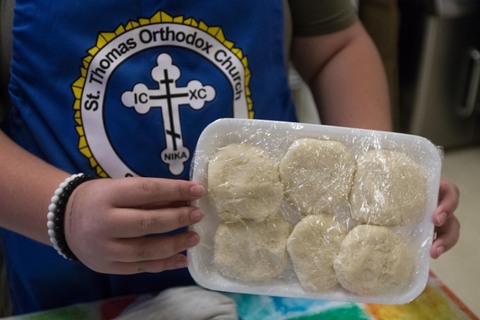
Mediterranean Delights: Iowa Ag Influences Syrian-Lebanese Church Dinner
Call it controlled chaos. Anyone who has ever helped with a church fundraising dinner knows just how hectic, harried and fun it can be to work together to prepare the meals. That’s especially true at St. Thomas Orthodox Church in Sioux City.
“It’s a lot of work and requires all hands on deck,” said Erica Stickney, a chairperson who helps coordinate St. Thomas’s popular Syrian-Lebanese dinner, which was held on Sept. 10 this year.
“While it can get a little frustrating at times when things get really busy and the kitchen’s hot, you remember that it’s about friendship and love, including love for God and the community.”
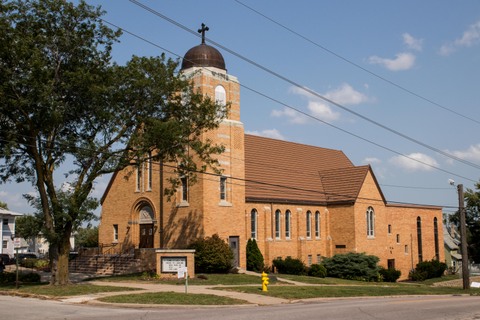
St. Thomas Orthodox Church has served the Sioux City community since 1916.
Homemade dinners at this year’s Syrian-Lebanese dinner, which was served from 12:30 p.m. to 6 p.m., cost $13 each, with a portion of the proceeds going to The Warming Shelter, a non-profit charity in Sioux City. While this year’s menu served plenty of Mediterranean favorites, many had a Midwestern twist. “Traditionally the meat would have been lamb, but we use beef, because we’re in Iowa,” Stickney said.
The menu included:
• Kibby (or kibbeh). This tasty meatloaf is made with lean ground beef and cracked bulgur wheat, seasoned with cinnamon and allspice.
• Yabrah. Much like cabbage rolls, yabrah includes cabbage leaves that are rolled and stuffed with a spiced blend of beef, rice and tomatoes. “We rolled 5,515 of these this year,” said Sue Stevens of Sioux City. “It’s rewarding to hear our guests say the cabbage rolls are perfect.”
• Lubee. This simple, yet satisfying side dish, features green beans in a tomato and meat sauce.
• Ruz. This Syrian favorite includes buttery white rice accented with tiny orzo pastas.
• Salata. This Syrian salad is enhanced with the church’s special dressing made of oil, vinegar, lemon juice and seasonings.
• Talamee. These big, round loaves of Syrian bread are indescribably tasty, report church members.
• Baklawa. Sometimes called baklava, this classic Mediterranean dessert is made with phyllo pastry dough, butter, and walnuts in a sweet syrup.
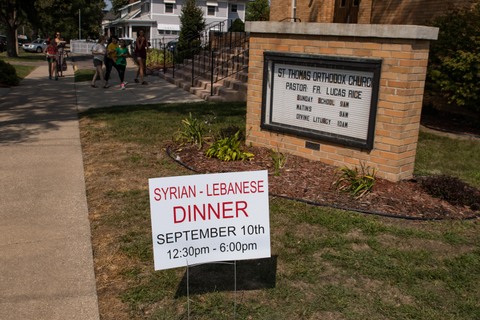
A steady stream of people stopped by St. Thomas Orthodox Church in Sioux City in September 2017 for the popular Syrian-Lebanese dinner.
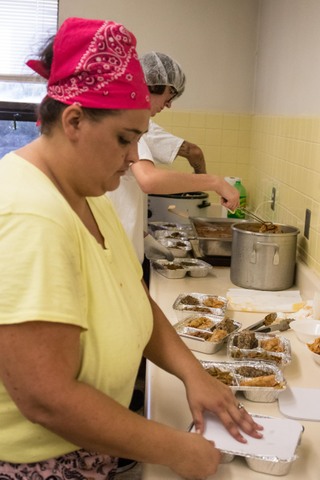
Erica Stickney, a chairperson who helps coordinate St. Thomas’s popular Syrian-Lebanese dinner in Sioux City, dished up countless carryout dinners.
Diverse influences create beloved traditions
While St. Thomas is located in the heart of Sioux City, the parish’s heritage, much like its dinner specialties, reflects a mix of Mediterranean and Midwestern influences. The church was founded in 1916 to serve the needs of Arab Christian immigrants, many of whom came to the area to work in the Sioux City Stockyards or local meatpacking plants. Today’s members embody a diverse background of Mediterranean, Russian, Serbian and Romanian heritage.
“Historically, Sioux City has been very welcoming and accepting of newcomers,” said Father Lucas Rice, who has served the St. Thomas parish more than six years. “When I came here, I was also blown away by how much the people of Siouxland love the St. Thomas church dinner.”
While no one’s sure exactly how long St. Thomas’s congregation has been hosting the dinner (anywhere from 50 years to nearly 80 years, depending on who you ask), there’s no doubt that people mourned the loss of the dinner when the church discontinued it for a few years.
“We hadn’t hosted the dinner in three years, because our church demographics were changing and the older generation was stepping down,” said Stickney, who noted that previous generations cooked without recipes and made their own phyllo dough. “The younger generation had to decide the next steps, and we decided to carry on the tradition.”
Before the older generation retired, younger cooks in the church worked side by side with the experienced cooks so they could observe each step of the process. “We would stop them as they added ingredients so we could determine the measurements and write the recipes,” Stevens said. “While we follow the recipes, we taste the food as we prepare it to make sure it’s right.”
Church members prepared to serve 1,400 dinners on Sept. 10. The process started three weeks before the dinner. “We begin by clarifying the butter,” said Stickney, who noted that 236 pounds of butter are used to prepare the cookies, rice and more. “Clarified butter has the milk solids removed and influences the taste and look of the food.”
The bread is baked on the Saturday right before the dinner, and the rest of the dishes are prepared fresh the day of the church dinner. “I love to come back for this dinner,” said Rick Stevens of Lincoln, Nebraska, whose family has been part of the St. Thomas parish for generations. “This is home.”
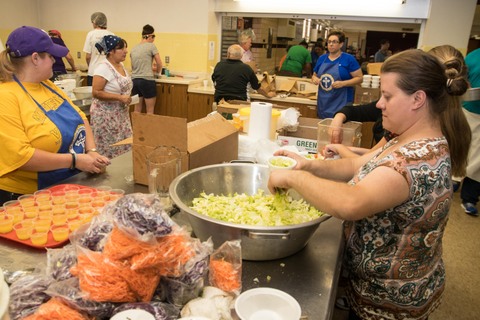
It’s all hands on deck in the basement kitchen at the St. Thomas Orthodox Church Syrian-Lebanese dinner and bake sale in Sioux City.
Clarified Butter
Slowly melt butter in pan on low heat. Be careful not to boil. When butter is completely melted, carefully skim all of the milk fat from the top and discard fat. The result is pure gold butter. This is used in most Arab recipes.
Ghraybeh (Lebanese Butter Cookies)
1 cup clarified butter
1 cup powdered sugar
2 cups flour
With hand mixer, whip butter until creamy pale and fluffy. Add sugar, and mix until fluffy. Using a large rubber spatula, blend in flour a little at a time.
Roll dough into balls and place on cookie sheet. Press to flatten. Work quickly so dough doesn’t get too soft. Bake in preheated oven (300 degrees) until cookies are firm, 10 to 12 minutes. Don’t let cookies get brown. Remove cookies from pan and let cool.
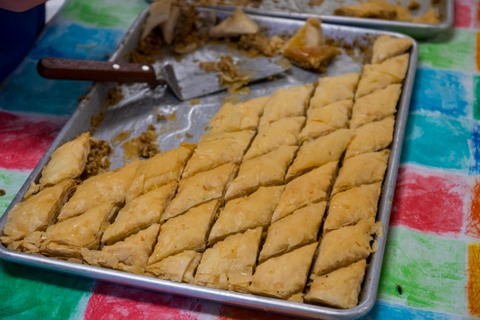
Homemade baklawa (baklava) is always in demand at the St. Thomas Orthodox Church Syrian-Lebanese dinner and bake sale.
Baklawa (also known as Baklava)
4 cups finely chopped walnuts
2 cups clarified butter-melted
1/8 cup granulated sugar
2 packages phyllo dough (20 sheets per package)
Combine walnuts with sugar and 1/4 cup butter so mixture forms a ball when squeezed in your hand.
Grease a large baking sheet with butter. Place one package of phyllo carefully on to baking sheet. Spread walnut mixture on top evenly. Carefully place second package of phyllo
on top of walnut mixture. Carefully take off top five layers of phyllo.
Butter the top layer of phyllo dough on the pan, and then place a single layer of phyllo on top of buttered layer. Repeat until all lawyers are back on to pan. Put butter on top layer. Cut into diamond shapes.
Bake in preheated, 375-degree oven for 25 minutes. Remove from oven. Pour a little butter on the top evenly. Place pan back into the oven for another 20 minutes or so, until the baklawa is golden brown.
Remove pan from oven and place on cooling rack. Immediately pour syrup mix (see recipe below) evenly on top of entire pan. Let pan sit for one day. Allow syrup to soak through the entire dessert. You may want to re-cut baklawa before removing from pan.
Syrup for Baklawa
2 1/2 cups granulated sugar
1 1/2 cups water
1 tablespoon lemon juice
In a pan, heat water and sugar until boiling. Once mixture starts to boil, add the lemon juice. Cook for another 15 minutes until the syrup starts to thicken. Remove pan from heat, and set aside to cool.
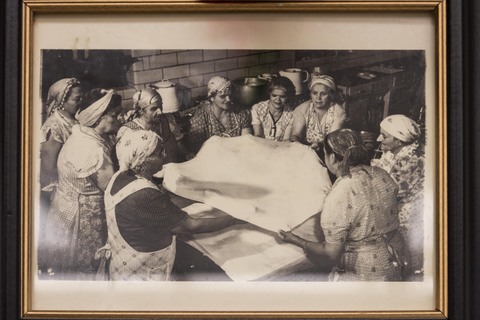
Previous generations of church members made their own phyllo dough at St. Thomas Orthodox Church in Sioux City, Iowa.
Barazek (Sesame Cookies)
1 cup butter
1/2 cup sugar
1 egg
1/2 teaspoon vanilla
3 cups flour
1/4 teaspoon salt
1 teaspoon baking powder
1/2 cup milk
3 tablespoons pistachios chopped
1 egg white
3 tablespoons sesame seeds
Preheat oven to 350 degrees. Cream butter and sugar with electric mixer until light and fluffy. Add egg and vanilla, continue beating. In separate bowl, mix flour, salt and baking powder. Stir flour mixture gradually into butter mix, alternating with milk.
Knead dough on lightly floured surface. Divide dough into two parts. Roll each piece into a circle, and cut into rounds. Place pistachios on a cookie sheet; spread evenly. Place dough rounds on top of pistachios, and press lightly. Beat the egg bite and then brush the tops of cookies. Sprinkle with sesame seeds. Bake about 15 minutes, or until golden brown.
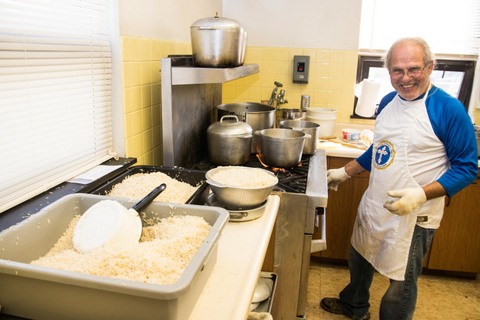
Ruz (a Syrian favorite of buttery white rice accented with tiny orzo pastas) is cooked in large quantities at the St. Thomas Orthodox Church Syrian-Lebanese dinner.
Want more?
Thanks for stopping by. I invite you to read more of my blog posts if you want more more intriguing Iowa stories and history, along with Iowa food, recipes and tips to make you a better communicator.
If you like what you see and want to be notified when I post new stories, be sure to click on the “subscribe to blog updates/newsletter” button at the top of this page. Feel free to share this information with friends and colleagues who might be interested, too.
If you’re hungry for more stories of Iowa history, check out my top-selling “Culinary History of Iowa: Sweet Corn, Pork Tenderloins, Maid-Rites and More” book from The History Press. Also take a look at my latest book, “Dallas County,” and my Calhoun County” book from Arcadia Publishing. Both are filled with vintage photos and compelling stories that showcase he history of small-town and rural Iowa. Order your signed copies today! Iowa postcards are available in my online store, too.
Let’s stay in touch. I’m at darcy@darcymaulsby.com, and yettergirl@yahoo.com.
P.S. Thanks for joining me. I’m glad you’re here.
@Copyright 2017 Darcy Maulsby & Co.

Tell Your Story—But How?
You hear it everywhere these days. “You’ve got to tell your story,” you’re told, whether you’re a farmer, a business professional or you’re someone trying to get your message across to your local or federal lawmaker.
It’s a refrain Sen. Joni Ernst emphasized when she spoke at the 2017 Iowa Ag Summit in Des Moines in August. “I know I always say, ‘Tell me your stories,’ but they are essential as we create the next Farm Bill,” she said. “I can share your stories with others on the Senate Ag Committee, especially those who are far removed from rural America.”
“Tell your story” also popped up again when I interviewed Brad Greenway, a South Dakota pork producer and 2016 America’s Pig Farmer of the Year. Created by the National Pork Board, this program honors a U.S. pork producer who excels at raising pigs using the We Care ethical principles and is committed to sharing his or her farming story with the American public.
“If we don’t share our stories, who will?” asked Greenway, who has traveled from Stanford University to Vienna, Austria, to speak to influential audiences about modern agriculture from the farmer’s point of view. It’s a perspective that’s not often heard, yet it’s essential, as Greenway and Ernst know.
So this begs the question—HOW do you tell your story? Storytelling is a role that can feel a little—or a lot—unsettling when you’re much more comfortable driving a tractor, raising livestock or growing crops.
As someone who knows farming and has worked as a professional communicator for 20 years, here are my top 5 storytelling tips to get you started:
1. Become a story detective. It’s amazing how many people I’ve interviewed through the years who don’t think they have an interesting story. That’s when I take off my farmer cap and put on my “detective cap” to dig a little deeper. Then I find out you own 30 restored Farmall tractors and love to go on tractor rides. Perhaps I learn you’ve mastered your mom’s molasses cookie recipe and have the blue ribbon to prove it. Or maybe I discover that you’re an avid learner when it comes to conservation practices on your farm, or you have a first-hand knowledge of why crop insurance is so important. All these things are interesting to others, trust me. They are also potential stories.
2. Know your audience. So you’ve identified some things that are important to you. Now the big question becomes, “What’s important to my audience?” The answer is vital to how you present your story. When I write an article for Farm News, I start by visualizing a farmer I know who might be interested in the topic and think, “What information can I share that would be most valuable to Bill?”
3. Learn how to listen. Knowing your audience is only possible when you listen to their needs, wants, concerns and aspirations. Ask plenty of questions, and truly listen to the answers. Put on your detective cap one more time to uncover the common ground you share with your audience. Then you’ll be better prepared to present your story in a way that resonates with your audience.
4. Pay attention to detail. Always be concise, since fewer words tend to deliver more power. Yet share enough relevant details (from the sights, sounds and smells to the emotions the topic stirs in you) to make your story come alive. Great storytelling is as much art as a science. Study the methods of people you encounter who are good storytellers, learn from them and keep practicing.
5. Don’t stop. Sharing your story isn’t a once-and-done. It’s an ongoing process, but the payoff is worth it. Keep at it, and you can become a trusted voice who provides a valuable resource for people (sometimes very powerful, influential people) who want to hear your stories. Like Brad Greenway said, if those of us in agriculture don’t share our stories, who will? I think we all know how that story goes.
By the way, if you want more storytelling tips or would like to share your own stories with me, I’d love to hear from you.
Want more?
Thanks for stopping by. I invite you to read more of my blog posts if you want more more intriguing Iowa stories and history, along with Iowa food, recipes and tips to make you a better communicator.
If you like what you see and want to be notified when I post new stories, be sure to click on the “subscribe to blog updates/newsletter” button at the top of this page. Feel free to share this information with friends and colleagues who might be interested, too.
If you’re hungry for more stories of Iowa history, check out my top-selling “Culinary History of Iowa: Sweet Corn, Pork Tenderloins, Maid-Rites and More” book from The History Press, as well as my Calhoun County” book from Arcadia Publishing, which showcases the history of small-town and rural Iowa. Order your signed copies today! Iowa postcards are available in my online store, too.
Let’s stay in touch. I’m at darcy@darcymaulsby.com, and yettergirl@yahoo.com.
P.S. Thanks for joining me. I’m glad you’re here.
@Copyright 2017 Darcy Maulsby & Co.
About me:
Some people know me as Darcy Dougherty Maulsby, while others call me Yettergirl. I grew up on a Century Farm
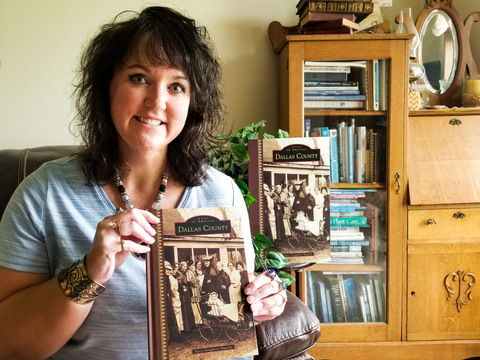
The Hotel Pattee and I are Hosting a Party—And You’re Invited!
What are you doing on Monday evening, Sept. 11? I would like to personally invite you to Perry to the historic Hotel Pattee at 7 p.m. for the debut of Dallas County, my latest non-fiction Iowa history book. It’s all here—drama, crime (Bonnie and Clyde), politics (Dallas County made President Harry Truman the original Comeback Kid), romance, tragedy, mystery, action, adventure, sports, food, agriculture, architecture, science, business, biography, comics and more—all told through more than 100 vintage photos and short stories in 10 chapters.
During this fun event at the hotel (click here for all the details!), I’ll take you on a time-traveling virtual tour of fun, surprising and sometimes shocking Dallas County history highlights. Stick around for the book signing after the program, and then stroll through the iconic Hotel Pattee to tour some of the guest rooms that will be open that evening. Every room in this grand boutique hotel features unique décor that tells the stories of Perry, Dallas County and Iowa history.
I’ve specifically asked that the luxurious Louis Armstrong Suite be open that evening. (In case you’re wondering about the Iowa connection, Louis Armstrong performed in Dallas County in 1954 at the legendary Lake Robbins Ballroom near Woodward and stayed at the Hotel Pattee.)
If nothing else, stop by on Sept. 11 for the homemade cookies the Hotel Pattee’s culinary team is preparing with some of my favorite recipes!
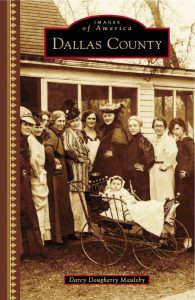 Explore forgotten Iowa history
Explore forgotten Iowa history
I am so excited to bring you this new hardcover, illustrated book, which is the first in-depth, non-fiction history of Dallas County, Iowa, in nearly 80 years!
No Iowa county has influenced American history more than Dallas County. It propelled Harry Truman to an unlikely victory in the 1948 presidential campaign, following a fiery speech he delivered to 100,000 farmers on a sweltering September day at the National Plowing Match near Dexter. Just 15 years earlier, a shoot-out near Dexfield Park marked the beginning of the end for infamous outlaws Bonnie and Clyde and the notorious Barrow Gang.
Dallas County, located just west of Des Moines, has produced several major-league baseball players (among them Bob Feller and Hal Manders), a US congressman (David Young), and Nile Kinnick, the 1939 Heisman Trophy winner and University of Iowa football legend whose grandfather George Clarke, of Adel, served as Iowa’s governor from 1913 to 1917.
Today, Dallas County is one of the fastest-growing counties in America and remains a region of opportunity with a rich heritage of small-town living, farming, coal mining, and the immigrant experience.
My 128-page book from Arcadia Publishing (order signed copies here) is filled with intriguing black-and-white, vintage photos on nearly every page, along with stories from Adel, Perry, Waukee, Granger, Woodward, Dexter, Linden, Minburn, Dawson, Dallas Center, Van Meter, Redfield, Bouton, surrounding rural areas and ghost towns.
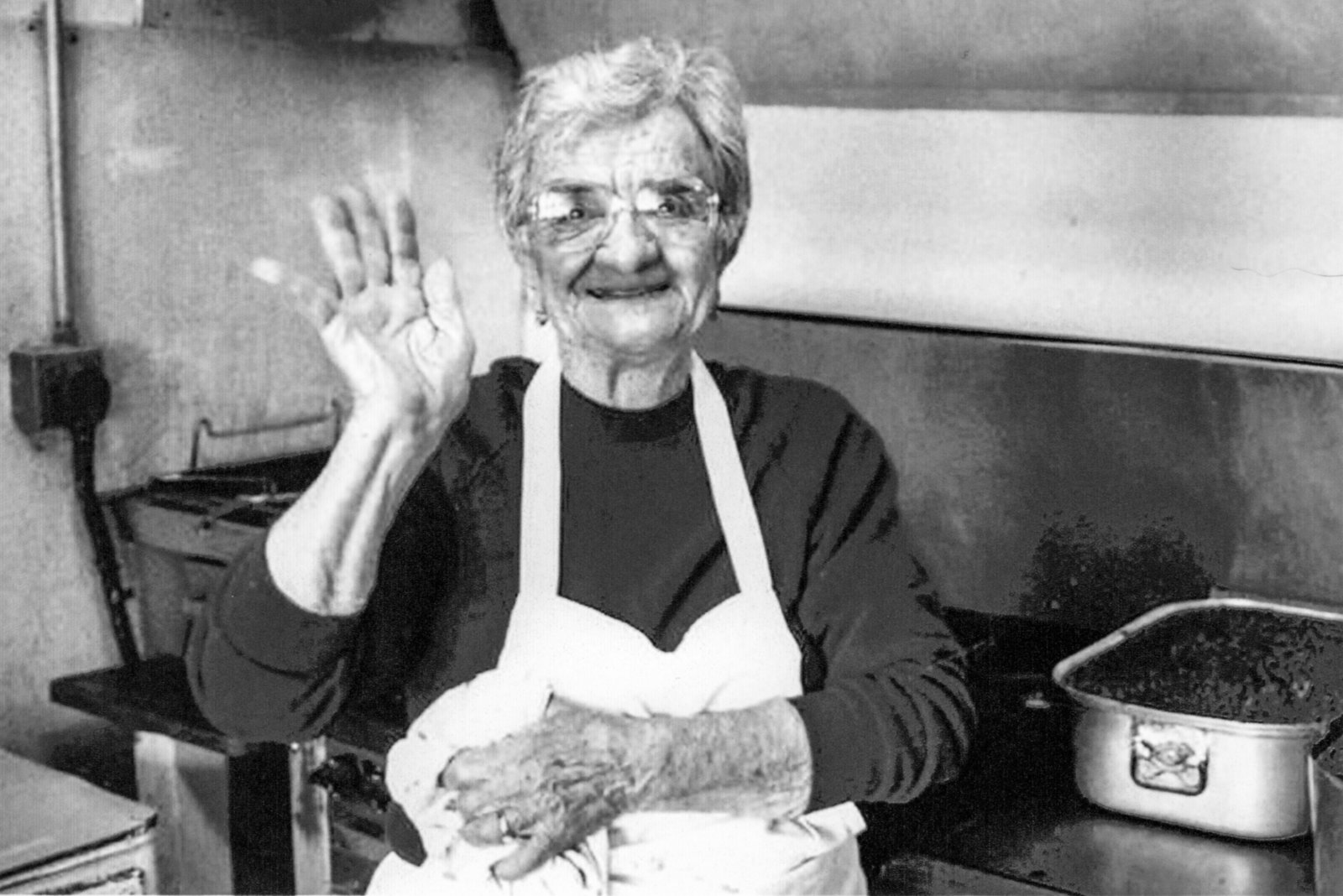
Alice Nizzi, owner of Alice’s Spaghettiland, an Italian restaurant open from 1947 – 2004 in Waukee. Source: Waukee Area Historical Society
Here’s a quick list of highlights that make this Dallas County book unique:
1. Many of the images have been donated from private collections.
2. In the early 20th century, Dallas County was one of the biggest coal-mining areas of Iowa. Much of this history, from Waukee to Woodward, is shared in this new Dallas County book. You can also get the inside story in this guest blog post I wrote for Hometown Heritage in Perry.
3. At least two circuses once made Dallas County their home base, including the famous Orton Bros. three-ring circus, where Five generations of the Orton family thrilled audiences for years. The Yankee Robinson Show, a Midwestern traveling circus, made its winter quarters two miles southeast of Granger. The spacious area also provided a place to bury deceased circus elephants. Granger may be the only Iowa town to claim an elephant graveyard.
4. Minburn’s legendary Singing Wheels roller skating show debuted in 1950 and ran through the early 1960s. Local children, high school students from the Minburn Roller Club and adults all participated in the Singing Wheels’ summer performances, which included a new theme every year, eye-catching costumes, and choreographed routines. These shows attracted thousands of people to the Minburn roller skating rink.
5. The Lake Robbins Ballroom, which opened on November 11, 1931, near Woodward, is still a popular entertainment destination and is one of the few remaining ballrooms in Iowa. The legendary Louis Armstrong performed at Lake Robbins in 1954 and stayed at the Hotel Pattee in Perry, where the most luxurious suite in the hotel is named in his honor.
6. Granger became the focal point of a successful New Deal program inspired by Monsignor Luigi Ligutti, who had served Assumption Church in Granger since 1926. Ligutti felt coal camps were an unsuitable environment for children and looked to the land to address the miners’ economic and social challenges. The 225-acre Granger Homesteads, built in 1935, included 50 modern homes, along with approximately four acres each for raising crops and livestock. In 1936, First Lady Eleanor Roosevelt visited the Granger Homesteads and praised the success of the project.
7. The KKK was active in Dallas County, especially Perry, in the early 1920s. Almost 15,000 people witnessed a KKK parade and semi-public meeting in Perry on May 31, 1924.
8. Dallas County is one of the fastest-growing counties in America and remains a region of opportunity with a rich heritage of small-town living, farming, coal mining, and the immigrant experience.

While Bonnie and Clyde escaped, Clyde’s older brother, Buck Barrow (shown lying on the ground), was mortally wounded during a shootout with law enforcement during the early morning hours of July 24, 1933, near Dexfield Park in southern Dallas County. Buck would die a few days later at Kings Daughters Hospital in Perry. Source: Dexter Museum
Click here to order your signed copy today! Priceless memories of Iowa history make a great gift, too.
• Series: Images of America
• Hardcover: 128 pages
• Publisher: Arcadia Publishing (September 4, 2017)
Want more?
Thanks for stopping by. I invite you to read more of my blog posts if you want more more intriguing Iowa stories and history, along with Iowa food, recipes and tips to make you a better communicator.
If you like what you see and want to be notified when I post new stories, be sure to click on the “subscribe to blog updates/newsletter” button at the top of this page. Feel free to share this information with friends and colleagues who might be interested, too.
If you’re hungry for more stories of Iowa history, check out my top-selling “Culinary History of Iowa: Sweet Corn, Pork Tenderloins, Maid-Rites and More” book from The History Press, as well as my Calhoun County” book from Arcadia Publishing, which showcases the history of small-town and rural Iowa. Order your signed copies today! Iowa postcards are available in my online store, too.
Let’s stay in touch. I’m at darcy@darcymaulsby.com, and yettergirl@yahoo.com.
About me:
Some people know me as Darcy Dougherty Maulsby, while others call me Yettergirl. I grew up on a Century Farm between Lake City and Yetter and am proud to call Calhoun County, Iowa, home. I’m an author, writer, marketer, business owner and entrepreneur who specializes in agriculture. Learn more at www.darcymaulsby.com.
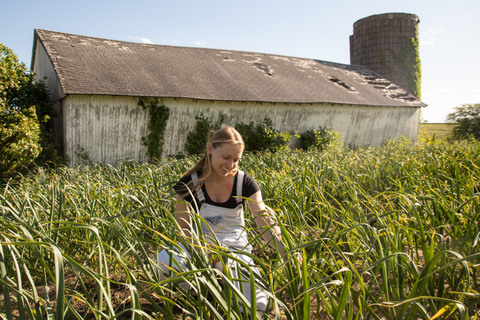
Ultra-Local Eating: Jennifer Miller Guides CSA, Iowa Food Cooperative
Jennifer Miller could hardly believe the question. “When will your bananas be ready?” inquired a central Iowa woman who was buying fresh produce through Miller’s Clarion Sage market garden and community supported agriculture (CSA) business near Waukee.
“People are disconnected from where their food comes from,” said Miller, 30, who noted the woman seeking locally-grown bananas is a well-educated business professional. “I’ve even had people look at our heirloom tomatoes and say, ‘I don’t want those,’ because they think they are GMOs.’”
This disconnect isn’t all that foreign to Miller, who grew up in Highland Park, Illinois, a northern suburb of Chicago. “I had no contact with agriculture in Highland Park,” said Miller, who serves as the Iowa Food Cooperative’s member services coordinator.
Miller did have a connection with Iowa, though, through her paternal grandparents, who lived in the Clarion/Rowan area. Her decision to move to Iowa in 2010 was spurred, in part, by a health challenge and new-found passion for healthy eating.
Miller was diagnosed a number of years ago with celiac disease, a serious autoimmune disorder where consuming gluten can damage the small intestine. “I started caring more about cooking and healthy recipes, because I just wanted to feel better,” said Miller, whose gluten-free and vegan recipes on her blog caught the attention of Martha Stewart Living editors, who invited her to develop recipes for them. “That’s what got me into food and agriculture.”
Food can be so much more interesting
After moving to Iowa, Miller got involved with community gardens in the Des Moines area and became a marketing/communications specialist Iowa Food Cooperative, which operates like an online farmers market. In 2013, Miller and her partner, Cody Kilgore, moved to an acreage on the southwest edge of Waukee’s city limits in Van Meter Township so they could operate their own farm.
“It felt like coming full circle,” said Kilgore, who was raised in rural Missouri, worked in the corporate world for nearly 30 years and was ready for a career switch.
 The couple planted garlic in the fall of 2013 to start their Clarion Sage market garden. The goal? “We believe in ultra-local and want to feed the community around us,” said Miller, who noted that Clarion Sage primarily serves families within a five-mile radius in southern Dallas County.
The couple planted garlic in the fall of 2013 to start their Clarion Sage market garden. The goal? “We believe in ultra-local and want to feed the community around us,” said Miller, who noted that Clarion Sage primarily serves families within a five-mile radius in southern Dallas County.
Today, Miller and Kilgore raise a wide array of vegetables and herbs, including lettuce, squash, cabbage, carrots, garlic, tomatoes, cucumbers, peppers, potatoes and more, including heirloom varieties that can’t be found in most stores. They offer an online ordering system for added convenience.
“Food can be so much more interesting,” Miller said. “Whether you’re sharing a family meal, providing snacks for your kids or making a favorite recipe, one thing’s for sure: the starting point for all these is good food.”
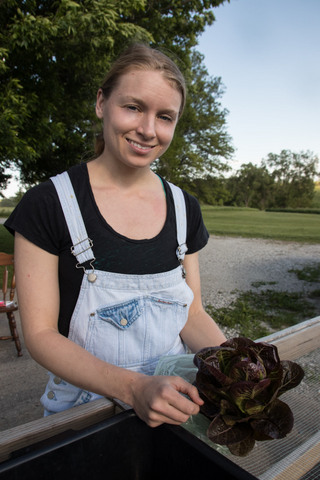
Jennifer Miller displays one of the unique lettuce varieties she grows at Clarion Sage Farm near Waukee.
Six lessons learned about farming and food
As their business evolved, Miller and Kilgore have adjusted their marketing plan to adapt to the often surprising—and sometimes frustrating—buying patterns they’ve observed in the market. The Clarion Sage market garden and CSA have taught them six key lessons, including:
1. Farming is more than production. Raising an abundant crop is just step one, said Miller, who has learned that that marketing and sales are equally important.
2. Mentors matter. “I didn’t grow up gardening, so working for various produce growers in Iowa and beyond taught me so much,” said Miller, who is grateful for leaders like Angela Tedesco who started Turtle Farm near Granger, Jill Beebout from Blue Gate Farm near Chariton and other local food proponents who have mentored her along the way.
3. Buying local adds flavor to life. Clarion Sage’s customers appreciate the “know your farmer” philosophy. Most buyers tend to be in their 30s and 40s with families, or they’re retired and have an interest in good food and time to cook. “Every week we offer our customers about $30 worth of fresh vegetables,” Miller said. “We focus on staple items like lettuce, potatoes, carrots and tomatoes, with the opportunity for more exotic options like stir-fry greens, kale and eggplant.”
4. Catering to consumers can be tricky. While the Clarion Sage CSA is right on Waukee’s doorstep, some consumers don’t want to drive to the farm to pick up vegetables. Some feel they don’t have time, while others don’t like the way the gravel road makes their vehicle dusty. When Miller tried offering delivery, some consumers still rejected this option, citing a lack of time or interest in preparing fresh food. Even full-color newsletters filled with cooking tips and recipes failed to gain much traction with these types of consumers, said Miller, who plans to start selling her produce at the Downtown Farmers’ Market in Des Moines.
5. Urban sprawl is relentless. High-density residential projects are planned for the area near the Clarion Sage’s market garden. “We’re in the bullseye of urban sprawl, which is a challenge,” said Kilgore, who also works as a wedding photographer.
6. Local food pairs well with global flavors. Miller loves ethnic cooking, from Latin American to African. “If you want to add more vegetables to your diet, look to other cultures that don’t have an abundance of meat protein,” said Miller, who encourages people to try vegetables like Cherokee Purple heirloom tomatoes (known for their smoky, complex flavor), fish peppers (which pack more heat), Merlot lettuce (whose dark red leaves offer a mellow flavor) and fingerling potatoes (which taste great fried or roasted).
Food is one of the best parts of life, added Miller, who loves the creativity involved in growing and marketing a crop. “You see a crop through from beginning to end, and you’re producing something that can feed and sustain people. That’s amazing to me.”
Want more?
Thanks for stopping by. I invite you to read more of my blog posts if you want more more intriguing Iowa stories and history, along with Iowa food, recipes and tips to make you a better communicator. If you like what you see and want to be notified when I post new stories, be sure to click on the “subscribe to blog updates/newsletter” button at the top of this page. Feel free to share this information with friends and colleagues who might be interested, too.
If you’re hungry for more stories of Iowa history, check out my top-selling “Culinary History of Iowa: Sweet Corn, Pork Tenderloins, Maid-Rites and More” book from The History Press, as well as my Calhoun County” book from Arcadia Publishing, which showcases the history of small-town and rural Iowa. Order your signed copies today! Iowa postcards are available in my online store, too.
Let’s stay in touch. I’m at darcy@darcymaulsby.com, and yettergirl@yahoo.com.
P.S. Thanks for joining me. I’m glad you’re here.
@Copyright 2017 Darcy Maulsby & Co.
About me:
Some people know me as Darcy Dougherty Maulsby, while others call me Yettergirl. I grew up on a Century Farm between Lake City and Yetter and am proud to call Calhoun County, Iowa, home. I’m an author, writer, marketer, business owner and entrepreneur who specializes in agriculture. Learn more at www.darcymaulsby.com.
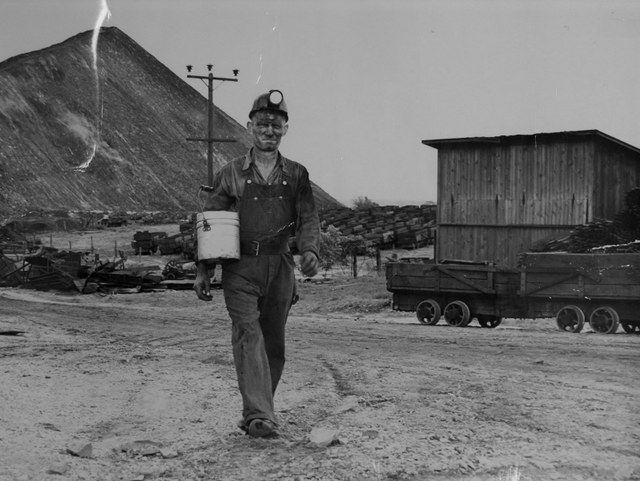
Iowa Underground – How Coal Mining Fueled Dallas County’s Growth
There was a time when Dallas County was one of the most important coal-mining counties in Iowa. While this way of life vanished decades ago, the memories live on, from rooms at the historic Hotel Pattee in Perry to the coal-mining museum in the Waukee Public Library to the many descendants of mining families who still live in the area.
From Moran to Woodward to Waukee, Dallas County thrived with the increased demand a century ago for coal to power train locomotives and heat businesses and homes. Coal was a relatively cheap, plentiful energy source. With ample supplies of coal, Dallas County became a land of opportunity for immigrant miners from Europe and beyond.
Coal mining started in the Van Meter area as early as the 1870s. By the early 1900s, coal was discovered in Des Moines Township east of Woodward, leading to the creation of the Scandia and Phildia mining settlements. After the Phildia mine was abandoned in 1915 and the Scandia mine closed in 1921, miners moved on to the Moran mine, which opened in 1917 west of Woodward.
It’s not on most maps today, but there was a time when Moran was a bit of a boom town.Another mining town–Angus–was an even bigger boom town north of Perry. The Angus & Moran Room at the Hotel Pattee in Perry recalls the history of these areas, which are now little more than ghost towns.
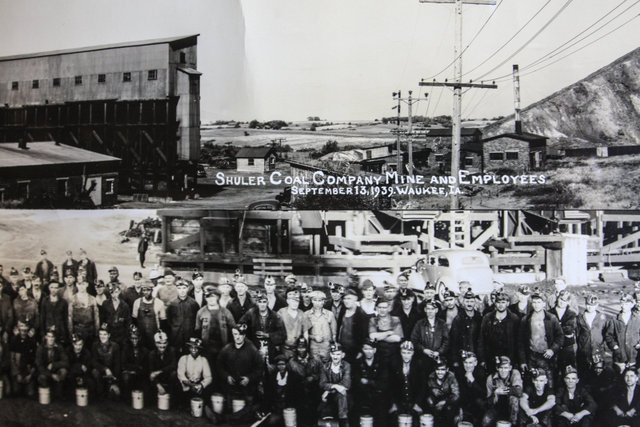
Shuler Coal Mine and employees shown here on September 13, 1939, in Waukee, Iowa. The mine was open from 1921 to 1949. Source: Waukee Area Historical Society
Living with danger
On the opposite side of Dallas County, coal mining also transformed the Waukee area in the early twentieth century. The Harris Mine opened on September 20, 1920, just two and a half miles northeast of Hickman Road in Waukee.
By 1921, the Shuler Coal Company of Davenport, Iowa opened a coal mine on Alice’s Road, one mile east of the Harris Mine. At its peak production, the mine employed more than 450 men.
The Shuler Mine became one of the largest producers of coal in Iowa, and it had one of the deepest mine shafts–387 feet deep. The mine produced coal for Iowa State University, as well as for local railroads, businesses and homes.
The miners worked in the Shuler mine with the help of more than 30 mules, bringing up hundreds of tons of coal per day and millions of tons of coal over the mine’s 28 years of operation. The miners’ work day often started at 6 a.m., and they wouldn’t return home until 4 or 4:30 p.m.
Mining was dangerous, dirty work. Miners used dynamite, as well as heavy picks, to break coal loose from the coal veins. When the siren blew, it was a sign that a miner was in trouble, or there had been a cave-in.
“I can remember the whistle blowing in succession to let people know there had been an accident,” noted Angelo Stefani, whose uncle was killed in a mining accident. “I can also vividly member women coming out of their homes to see what happened. They were hysterical.”
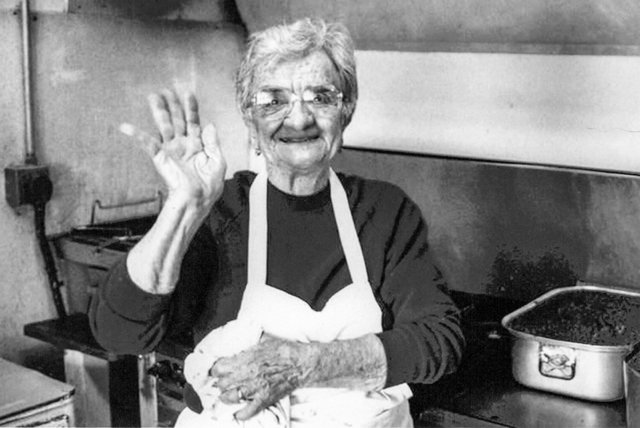
Alice Nizzi was the founder and owner of the beloved Alice’s Spaghettiland, an Italian restaurant open from 1947 – 2004 in the Waukee area. Source: Waukee Area Historical Society
Life in Waukee’s coal mining community
The Shuler mining camp was home to Italians, Croatians and people of other ethnicities. Most families lived in small, simple houses with no running water, but they often raised chickens and tended enormous gardens where they grew a variety of vegetables.
Work wasn’t always steady. Dallas County’s coal mines often closed in the summer, when demand for coal dropped off in the warmer months. Miners would often work for local farmers or do odd jobs around the community to help pay the bills.
Some of the miners’ wives, especially those in Italian families, worked at local restaurants like Rosie’s and Alice’s Spaghettiland near Waukee to supplement the family’s income. Alice Nizzi (1905–1997) opened Alice’s Spaghettiland in the Shuler mining community just north of Hickman Road in 1947. The restaurant’s waitresses were required to wear white, starched uniforms. Alice’s became a destination and Waukee-area institution for decades until it closed in 2004.
The Waukee Area Historical Society hosted a fundraising dinner in the spring of 2014 featuring Alice’s spaghetti and Italian salad. Hundreds of people now attend this fun event, which has been held each April for the past few years.
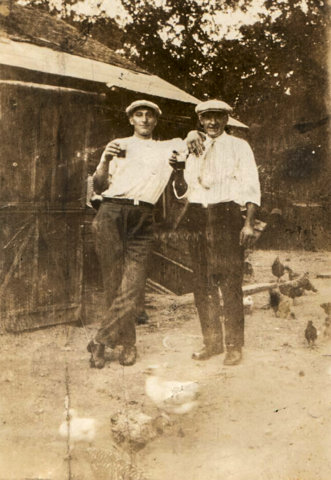
Terzo Fiori (left) and Pete Nizzi enjoyed tasting their homemade wine. Excitement spread through Waukee’s mining camps when grapes were imported from California and shipped by train in two boxcars so families could make their yearly supply of red wine.
Remembering the grape trains
For Italian families in the Shuler mining camp, one of the highlights of the year was the arrival of the annual trainload of grapes for making homemade wine.
“Excitement spread throughout the camp when the train arrived, and most of the people from the mining camp came to help unload the box cars,” said Gilbert Andreini, whose memories are recorded at the coal mining museum at the Waukee Public Library. “It was like a celebration.”
The end of an era
By the time the Shuler mine closed in 1949, Iowans began looking to energy sources other than coal for home use, such as electricity, natural gas and heating oil. In addition, the railroads were converting from steam to diesel engines, reducing the need of coal for locomotives.
While Dallas County’s coal mines have vanished into history, those who grew up in the mining camps will never forget how these areas grew into close-knit communities. Everyone knew everyone else and helped each other out, recalled Bruno Andreini.
“I’m very proud of those times. Anyone from that community is like a brother or sister to me. Even though we were poor, we had things that were far more valuable than money.”
Note from Hometown Heritage
I originally wrote this as a guest blog post for Hometown Heritage in Perry. Here’s a note from Hometown Heritage:
If you’d like to meet Darcy, hear more of her stories, and enjoy some Dallas County-inspired snacks, Darcy will be speaking at Hotel Pattee on September 11th, 2017, from 7 – 9 pm as part of Hometown Heritage’s fall programming series. For more information on this, please visit our website.
You can also learn more about Darcy on her website (www.darcymaulsby.com), and her new Dallas County book is available for pre-order on Amazon.
Want more?
Thanks for stopping by. I invite you to read more of my blog posts if you want more more intriguing Iowa stories and history, along with Iowa food, recipes and tips to make you a better communicator. If you like what you see and want to be notified when I post new stories, be sure to click on the “subscribe to blog updates/newsletter” button at the top of this page. Feel free to share this information with friends and colleagues who might be interested, too.
If you’re hungry for more stories of Iowa history, check out my top-selling “Culinary History of Iowa: Sweet Corn, Pork Tenderloins, Maid-Rites and More” book from The History Press, as well as my Calhoun County” book from Arcadia Publishing, which showcases the history of small-town and rural Iowa. Order your signed copies today! Iowa postcards are available in my online store, too.
Let’s stay in touch. I’m at darcy@darcymaulsby.com, and yettergirl@yahoo.com.
P.S. Thanks for joining me. I’m glad you’re here.
@Copyright 2017 Darcy Maulsby & Co.
About me:
Some people know me as Darcy Dougherty Maulsby, while others call me Yettergirl. I grew up on a Century Farm between Lake City and Yetter and am proud to call Calhoun County, Iowa, home. I’m an author, writer, marketer, business owner and entrepreneur who specializes in agriculture. Learn more at www.darcymaulsby.com.
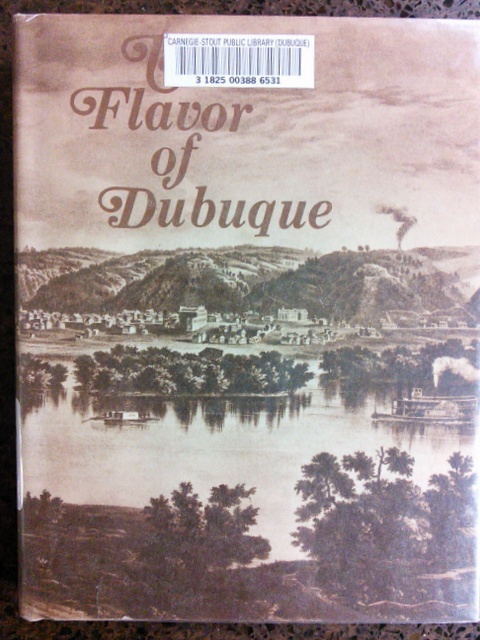
Let’s Have an Iowa Potluck with a Side of History!
Dubuque is home to some of Iowa’s most distinctive culinary traditions, from turkey dressing sandwiches to the memorable meals served at the iconic Hotel Julien Dubuque. We’re going to be eating up all this local flavor at a potluck on Sept. 7 at the Carnegie-Stout Public Library in Dubuque, starting at 5:30 p.m., followed by my “Culinary History of Iowa” program—and you’re invited!
Click here for all the details.
In meantime, here’s a sample of some classic Dubuque recipes to tempt you. These recipes come from a variety of sources, including two cookbooks (including The Flavor of Dubuque and Another Flavor of Dubuque) compiled by The Women’s Auxiliary of the Dubuque Symphony Orchestra. Not only do those cookbooks include tried-and-true local recipes, but they feature many photos of local landmarks. The third cookbook (Cedar Ridge Farm Recipes) appears to have been a collection of family recipes, and librarian Sarah Smith isn’t sure how it came to be in the Carnegie-Stout’s collection, but it’s charming.
Thanks, Sarah, for sharing these recipes and offering us a true taste of Dubuque!
One more thing–if you’re in Dubuque, stop by Cremer’s Grocery, a Dubuque classic since 1948, for their famous turkey dressing sandwiches and other goodies! Also, here are some fun facts about Dubuque, an All-American City that’s truly a “Masterpiece on the Mississippi:”
- Dubuque was settled by a French Canadian fur trader in the late 1700s named Julien Dubuque. In those days, Dubuque was known as the “gateway to the west.” Lead mining soon became the mainstay of Dubuque.
- There has been some type of hotel on the site of the Hotel Julien Dubuque since 1839.
- Some cool things to see in Dubuque include the National Mississippi River Museum and Aquarium, along with the Fenelon Place Elevator Company, which is the world’s shortest, steepest elevator ride!

Source: American Realty
The Flavor of Dubuque (published 1971)
Page 26
Derby Grange Steak. The present owners of what was the main farmstead in the area west of Dubuque long known as Derby Grange found this recipe behind an old picture of President Harding left by the previous owners. Cut 1 thick round steak into 1-inch pieces. Pound very thin and sprinkle with flour, salt, pepper, a little cumin and dill. Poud again and brown pieces on both sides in a little butter or other fat. Place in baking dish and pour over 1 cup tomato sauce. Bake, covered, at 300 degrees for 1 hour. Serves 7. Can be frozen. -Joan Mulgrew
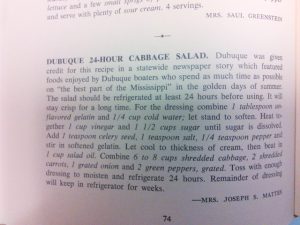
A Dubuque original –24-Hour Cabbage Salad
Page 74
Dubuque 24-Hour Cabbage Salad. Dubuque was given credit for this recipe in a statewide newspaper story which featured foods enjoyed by Dubuque boaters who spend as much time as possible on “the best part of the Mississippi” in the golden days of summer. The salad should be refrigerated at least 24 hours before using. It will stay crisp for a long time. For the dressing combine 1 tablespoon unflavored gelatin and 1/4 cup cold water; let stand to soften. Heat together 1 cup vinegar and 1 1/2 cups sugar until sugar is dissolved. Add 1 teaspoon celery seed, 1 teaspoon salt, 1/4 teaspoon pepper and 1 cup salad oil. Combine 6 to 8 cups shredded cabbage, 2 shredded carrots, 1 grated onion and 2 green peppers, grated. Toss with enough dressing to moisten and refrigerate 24 hours. Remainder of dressing will keep in refrigerator for weeks. -Mrs. Joseph S. Mattes
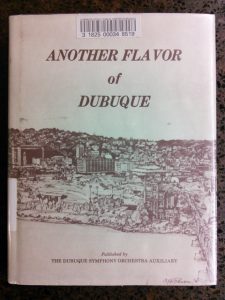
More recipes from Dubuque, Iowa
Another Flavor of Dubuque (published 1983)
Page 70
Welsh Rarebit. Shred 1/2 pound Cheddar cheese, put in double boiler and let melt slowly over hot water. Keep water below boiling point. Add 1/4 teaspoon dry mustard, paprika, salt and a few dashes cayenne pepper. Stir in 1 cup milk or cream and 1 teaspoon Worcestershire sauce. Mixture should be smooth and velvety. Serve on hot buttered toast. Strips of bacon are especially good over this.
Welsh Rarebit became a traditional Sunday night supper in the girls’ boarding school at Sinsinawa Mound (this is technically across the river in Wisconsin, but many of the students would have been from Dubuque.) The recipe’s simplicity and flexibility accommodated the varying number of returning students each Sunday night. It was sometimes served over tomatoes or ham. -Bette F. Schmid
Page 156
Dubuque Symphony Orchestra Auxiliary English Toffee. This delicious toffee was sold at the 1981 Designer Showcase, and the Auxillary has had many, many requests for the recipe. Line cookie sheet with foil. In heavy pan mix 1 cup sugar, 1/2 pound butter, 1/4 cup water, 1/4 teaspoon salt, 1/2 teaspoon vanilla and 1 cup chopped pecans. Cook quickly over medium high heat, stirring constantly, to a rolling boil. Cook to hard crack stage, 300 degrees on candy thermometer. Pour on cookie sheet. Cool and break into pieces. Store in air tight container. Do not freeze, refrigerate or make substitutions in recipe. -Mary Stauffer
Cedar Ridge Farm Recipes by Rita Tarnutzer Montgomery (published 1999)
Page 69
Chocolate Chip Cookies (Monster Cookies)
1/2 cup margarine
1/2 cup shortening
1 cup brown sugar
1 cup white sugar
1 teaspoon vanilla
2 eggs
1 cup oatmeal
1 cup corn flakes
2+ cups flour
1 teaspoon baking powder
1 teaspoon baking soda
12 ounces chocolate chips
Bake for 10-12 minutes at 350 degrees.
NOTE from Rita: For Monster Cookies, form into 5 oz. balls and flatten into 7-inch diameter circles, two to a cookie sheet. Bake for about 14 minutes at 350 degrees. Makes 8 cookies.
In 1976, when Al had his first antique shop, on 16th and Central Ave., he had a huge glass cookie jar. His idea was to display a couple of really big cookies in it. Everyone wanted to buy them! So, I began baking these monster cookies, 32 at a time and selling them for twenty-five cents each. (They cost twelve cents each to make.) I couldn’t keep up with the demand, so he raised the price to thirty-five cents and still they sold. School kids stopped on their way home from school and bought a cookie to share!
Page 159
Turkey & Dressing Sandwiches
from Janet Duscher, 12/88
Bake in a covered roaster until meat falls from bones: 1 – 12 lb. turkey
Remove meat from bones and chop.
Cook together:
1 1/2 cups cooking juices
3/4 cup margarine
2 1/2 cups chopped celery
3 medium onions, chopped
2 tablespoons sage
2 teaspoons poultry seasoning
1 – 1 ½-ounce package dry onion soup mix
1 – 10 3/4 ounces cream of chicken soup
Cube: 2 loaves of day-old bread (about 6 quarts)
Stir together bread cubes, juices with vegetables and seasonings and turkey.
Bake in a greased pan at 350 degrees until heated thoroughly, about one hour.
Serve hot in buns.
Want more?
Thanks for stopping by. I invite you to read more of my blog posts if you want more more intriguing Iowa stories and history, along with Iowa food, recipes and tips to make you a better communicator. If you like what you see and want to be notified when I post new stories, be sure to click on the “subscribe to blog updates/newsletter” button at the top of this page. Feel free to share this information with friends and colleagues who might be interested, too.
If you’re hungry for more stories of Iowa history, check out my top-selling “Culinary History of Iowa: Sweet Corn, Pork Tenderloins, Maid-Rites and More” book from The History Press, as well as my Calhoun County” book from Arcadia Publishing, which showcases the history of small-town and rural Iowa. Order your signed copies today! Iowa postcards are available in my online store, too.
Let’s stay in touch. I’m at darcy@darcymaulsby.com, and yettergirl@yahoo.com.
P.S. Thanks for joining me. I’m glad you’re here.
@Copyright 2017 Darcy Maulsby & Co.
About me:
Some people know me as Darcy Dougherty Maulsby, while others call me Yettergirl. I grew up on a Century Farm between Lake City and Yetter and am proud to call Calhoun County, Iowa, home. I’m an author, writer, marketer, business owner and entrepreneur who specializes in agriculture. Learn more at www.darcymaulsby.com.


